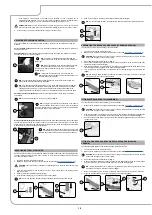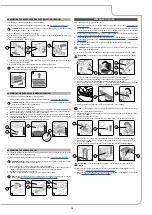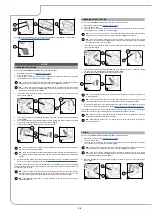
GENERAL SAFETY REGULATIONS
The following symbols are used to indicate any potentially hazardous situations. Always read
this information carefully and take the necessary precautions to protect any people and/or
objects that may be present.
Operator cooperation is paramount for accident prevention. No accident prevention programme
can be effective without the full cooperation of the person directly responsible for the machine's
operation. Most accidents that occur at the workplace, during work activities, or while in transit,
are caused by the failure to respect the most basic safety regulations. An attentive, careful
operator is most effective guarantee against accidents and is fundamental in order to implement
any prevention programme.
DANGER
: Indicates an imminent danger that could cause serious injury or death.
WARNING
: Indicates a probable dangerous situation that could cause serious injury or
death.
CAUTION
: Indicates a probable dangerous situation that could cause minor injuries.
ATTENTION
: Indicates a probable dangerous situation that could damage objects.
N.B.
: Indicates a note regarding essential or useful functions.
CONSULTATION
: Indicates the need to consult the Operator's Manual before performing
any operation.
RECHARGING THE BATTERIES
DANGER:
• If the battery charger power cable is damaged or broken, it should be replaced by the
manufacturer, by authorised service personnel or else by a qualified person, in order to
protect against hazards.
• The socket for the battery charger cable must have a prescribed earth connection.
•
Keep sparks, flames, and incandescent materials at a safe distance from the batteries.
Explosive gases are emitted during the charging phase.
• highly explosive hydrogen gas is generated while charging the batteries. Keep the recovery
tank in a maintenance position during the entire battery recharging cycle, and only perform
the procedure in well-ventilated areas at a safe distance from any open flames.
• Before charging, make sure the electric cable that connects the machine's electrical system
to the batteries is not damaged. If it is, don't use it; contact technical assistance.
• Before charging check that the electric cable that connects the battery charger to the mains
is not damaged, and if it is damaged do not use it and contact technical assistance.
• Do not disconnect the battery charger cable from the cable connected to the batteries when
the battery charger is in operation. This is to prevent electric arcs from forming. To connect
the battery charger while charging, the battery charger must first be switched off and then
the power supply cable must be disconnected from the mains socket (read the Use and
Maintenance Manual for the battery charger itself).
5
































